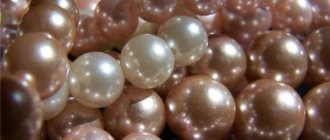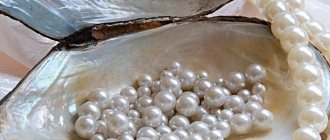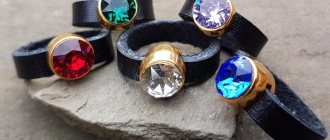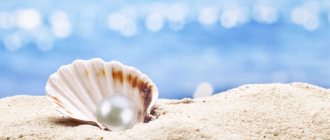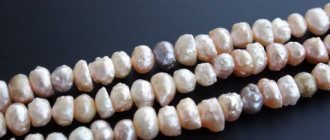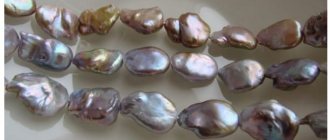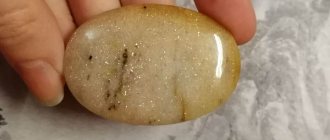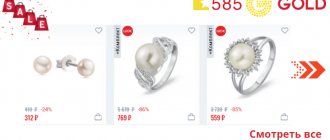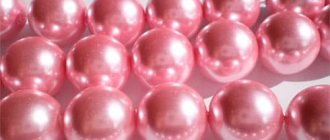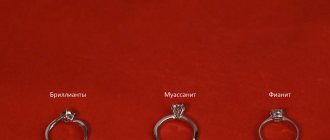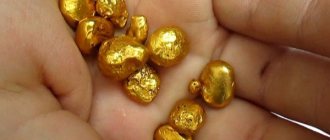Pearls are perhaps the most famous gemstone for jewelry. Thanks to its elegance and versatility, it is extremely popular among the fairer sex.
In nature, the mineral is created by sea mollusks ; it takes years to form 1 pearl. Therefore, people have learned to recreate such conditions and cultivate pearls on an industrial scale.
Cultured pearls: how they are grown
It is important to immediately understand that when a seller offers to buy jewelry with cultured pearls, we are not talking about a fake. Cultured pearls also grow in mollusk shells, but the conditions for this are specially created by humans on equipped farms.
To start the process of pearl formation, a grain of sand is placed into the shell with careful manipulation. The mollusk reacts to it as if it were a foreign body and begins to neutralize it: it secretes a secretion containing nacre. It envelops the grain of sand in circles, forming a pearl.
The entire process from introducing a foreign body into the shell and growing the pearl to its extraction is controlled by humans. The process is long: on average, the formation of a pearl with a diameter of 1 cm takes from 1 to 7 years, depending on the type of mollusk and the method of cultivation.
China and Japan hold the lead in pearl cultivation - these countries have the most favorable climatic conditions for such a process. In Russia there are farms producing freshwater pearls , but their price does not allow them to recoup the costs of maintaining oysters.
Wild gifts of nature - how they appear
Natural pearls are formed under natural conditions in the shell of a living organism. The process is random and uncontrollable. It all depends on the entry of a small foreign body into the mollusk. Experiencing discomfort, the oyster tries to neutralize the foreign object and actively envelops it with pearlescent layers.
So, after a few years, in place of a grain of sand or a small pebble in the shell, a tiny pearl will form, the growth of which will increase throughout the life of the oyster. The rate of growth will be influenced by environmental factors. First of all, the level of ecology. The age of the “progenitor” will also be reflected on it. On average, the education process takes about 6-7 years.
Growing methods
There are 2 ways to add a foreign grain of sand to a mollusk.
Nuclear
With the nuclear method, a minimum of 2 individuals of mollusks is required. From the first, a piece of the mantle is taken, located directly under the well-developed nacreous layer of the shell. The fragment is transplanted into the mantle of the second shell , thereby increasing its ability to produce nacre.
A pearlescent grain of sand is placed in the second shell in the mantle cavity next to the previous implant. The shape of the foreign body must be exactly the same as the future pearl.
In this way, perfectly spherical sea pearls are grown.
Nuclear-free
The difference between this method is the arbitrary shape of foreign bodies. Ordinary grains of sand and shell fragments are planted into the shell of the mollusk, but a piece of mantle from the donor is not transplanted.
This method is less expensive, but the cost of the pearls produced is lower due to the quality and shape. Most freshwater pearls are produced using this method.
Advantages and disadvantages
Cultured pearls are more durable than natural materials. In addition, it has a significantly lower cost. A huge plus is the different attitude towards oysters. When wild specimens are caught, the mollusks die. On farms, an oyster can grow up to 5 pearls, after which it is released into the wild.
Helpful information
The only drawback of cultured stone is a lot of low-quality materials. Such decoration often breaks, loses color and shine, and breaks. Therefore, when choosing, you need to pay close attention to the manufacturer.
Sea and river “parents”
Saltwater pearls are valued more highly due to their larger sizes and ideal spherical shape. But for its cultivation it is necessary to strictly observe the temperature and chemical composition of the water.
A foreign body is placed in the reproductive system of the mollusk. The maximum number of pearls obtained is 3, they are cultivated for at least 2 years.
The complexity of the method lies in the fact that mollusks often die from such interference or reject grains of sand. If the water indicators deviate, the quality of the pearls deteriorates.
The “parents” of sea pearls are often bivalve molluscs Pinctada , giant tridacni, pinnae or mussels.
Interesting! Tridacnae lack nacre and are used to cultivate milk or pink pearls.
And in the pinna clam you can grow red, brown and even black pearls.
When producing freshwater pearls, a nacreous grain of sand is embedded in the mollusk's mantle, located just under the shell. A pearl sac is formed from the epithelium of a freshwater inhabitant, filled with nacre. At the same time, the mollusk retains the ability to grow and reproduce and safely endures the entire cultivation process.
Freshwater farms are established in natural reservoirs or rice fields, without requiring the creation of special conditions. The disadvantage of the river method is the uneven shape of the resulting pearls and the small size of the beads .
Among freshwater mollusks, species such as European, Dahurian or Kamchatka pearl mussel are used.
Marine cultivation
Precious minerals are grown by farmers. The method is the same, but the plantations are located on the open sea. This mineral is more valuable than freshwater. One shell can become home to several pearls. The largest number is three. The stones have the correct shape and a pleasant, delicate shine. The result is explained by the properties of sea salt water. Sea salt gives a special color, uniformity of tone, and unusual shine. The growth period for marine species is shorter. You can get a mature pearl in 7 years. But the technology has many disadvantages:
- natural phenomena: storms;
- temperature changes.
A sharp decline could lead to the death of farmers' years of work. When it gets colder, the mollusk begins to secrete acid, which corrodes the shell of the pearl. The ball becomes cloudy and non-shiny. It is clear that it is losing its value. Masters found a way to speed up ripening; they began to use a core called a seed.
How to dye pearls
To obtain colored pearls, they are cultured in different types of mollusks. The inner surface of the shells consists of the same substances as the pearl, so its pigment determines the color of the pearls.
For example, the Royal Strombus clam produces a deep pink pearl. A similar shade is also grown in giant tridacnas.
The Haliotis mollusk produces a blue-green color with many iridescences, and the shells themselves are used for decoration or art objects.
The golden-colored pearls are grown inside the melon shell.
A special type of pearl from Tahiti
The most expensive material is obtained in Tahiti. This is a type of black stone. The shade of pearls desired by many is iridescent or cobalt blue. Necklaces are created from round balls with a diameter of up to 11 mm. It is impossible to collect such decoration from one harvest. Pearls have been picked for a number of years. Not every master jeweler will be lucky enough to become the creator of such a miracle. The shade of the jewelry is comparable to witchcraft. Products do not easily decorate a person; they make the image unique, bright and extravagant.
Black pearls have special powers:
- allows you to look deep into yourself;
- helps to find new things;
- reveals the hidden abilities of the soul.
Types of cultured pearls
Depending on the origin, color and size of the pearls, all varieties of cultured pearls are divided into varieties .
Akoya
The Akoya variety is native to the coastal waters of the Japanese islands of Honshu and Kyushu. They are produced by marine mollusks Akoya kai (Pinctada variety) for 4 years. Distinctive features are a minimum size of 10 mm, shine and multi-colored tints on the surface. Several shades are supplied to the jewelry market .
Black temptation from Tahiti (Tahitian)
The rarest specimen with unique external characteristics. The color of the pearl is not completely black, but with a gray-blue tint, the surface shines like metal. Such stones are produced in remote Tahiti. To make beads from black pearls, you will need to collect material for more than one year , so such products are very expensive.
For scammers, unusual varieties of pearls are especially attractive, and they dye white pearls that color.
Carefully! You should buy products with black pearls only in specialized places and then submit them to jewelers for inspection.
South sea pearls
South sea pearls are valued for their beauty and quality. There are only 2 color varieties of this variety - white (bred in Pinctada silver lipped shellfish) and gold (P. Gold lipped) . Thanks to the constantly warm water temperature, pearls form faster and reach larger sizes (up to 2 cm).
Mollusks are larger than their northern counterparts and allow several pearls to be grown in one shell at once. The same property is used to introduce a large-diameter “seed” (for example, a one-year-old freshwater pearl), which reduces the time of formation of the final product.
Pride of Cortez
The surface of Cortez pearls has iridescent shimmers. The size is about 1 cm, but the layer of mother-of-pearl is thin - up to 2 mm. Color: silver, gray or brown.
Kasumi: freshwater variety (Kasumi)
Freshwater kasumi pearls have a teardrop shape. The color can be golden, white, purple or cream.
Keishi: pearl grains (Keshi)
Keisha pearls are grown in the shape of a bean. In this case, the thick layer of mother-of-pearl has uneven walls.
Mabe: blister pearls (mabe)
Mabe is grown in the shell of the mollusk itself, making the outer surface of the beads convex and the inner surface concave.
Biwa
Freshwater pearls are oblong in shape and are white, silver, cream, blue or greenish in color.
Majorca
Produced by a Spanish company. It is distinguished by the artificial formation of pearls. The glass base is immersed in solutions of pearl powder and fish scales, polished, covered with a layer of mother-of-pearl and irradiated with ultraviolet light. A technically controlled process produces perfectly round pearls with a uniform internal structure and an iridescent sheen on the surface.
Black stone
Natural pearls are a fabulous creation of nature. It's difficult to repeat. There are many types of pearl beads. The most unusual, according to many, is black. He's perfect. It does not require special processing or finishing. The value of the mineral is high. The pearls are clean and smoothly polished. Many people want to fake a miracle, since the mineral is grown in Tahiti, and it is difficult to get it.
Precious balls play in the rays of the sun, giving a metallic shine that other species do not have. In reality, the color of pearls is not black, but gray. Black also has other rich shades:
- red;
- green;
- blue;
- eggplant.
For counterfeiting, a white stone is used. Painting is carried out in special containers. That is why you should know where to buy real jewelry, and not become the owner of a fake.
Defects: which are acceptable and which are not
Once the pearls are removed from their shells, they are assessed according to a variety of parameters:
- form;
- color;
- shine;
- defects.
The last parameter is considered the most important: if a pearl of ideal shape and color has unacceptable defects, it will not be used for further jewelry production.
According to this criterion, pearls are divided into classes . AAA class minerals, free from any defects, have the highest degree of purity. Pearls with acceptable defects (indentations or bulges, spots invisible to the naked eye) are assigned class AA+ or AA.
View this post on Instagram
Publication from SEQUINS
